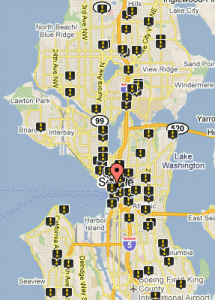SDOT has released a report on the Nickerson St road diet and found that by reducing the number of lanes for cars, safety has improved. Collisions, overall vehicle speeds, and the number of speeders have been reduced with minimal impact to traffic volumes. The Mayor outlines the good news:
Completed by the City in August 2010, the modifications have produced the following results:
- Reduced collisions by 23 percent over a one-year period (compared to the previous five-year average)
- Motorists traveling over the speed limit have declined by more than 60 percent
- Top-end speeders (people traveling 10 or more miles over the speed limit) have fallen by 90 percent
- The 85th percentile speed dropped from 40 mph and 44 mph westbound and eastbound to 33 mph and 33 Westbound and Eastbound. This is an 18 and a 24% reduction in speed.
- Traffic volumes remain roughly the same with no evidence of traffic diversion.
This is the 27th successful road diet implemented by SDOT since 1974. And, with yet another roadway safety measure in place, the question must be asked: why isn’t SDOT implementing more of these safety measures?
We recently pointed out that 28 pedestrians have died in locations that may be eligible for a road diet. Since then, we’ve profiled three streets that may be ideal candidates for SDOT to consider next: 35th Ave SW in West Seattle, 23rd Ave in the Central District / Judkins Park, and S Jackson St in the International District. Let’s compare these three streets with Nickerson St to see whether these other streets may deserve the same successful safety treatment as Nickerson and 26 other Seattle streets.
First, we’ll start by looking at traffic volumes. SDOT looks at the total number of cars that use a roadway before implementing a road diet. Streets with average daily traffic counts above 25,000 are not good candidates, and presumably lower volumes make for better candidates, though road diets have minimal impact on overall volume. Using SDOT’s 2010 traffic volumes, here are the four streets compared, from lowest volume to highest:
- Jackson St: ranges from 10,200-13,600
- 23rd Ave: 13,400
- 35th Ave SW: ranges from 16,100-22,700
- Nickerson St: 22,300
Let’s look at another metric. While Walk Score is not an official criteria used by SDOT, it indicates the walkability of a location and is correlated with the number of pedestrians in an area. Streets with more pedestrians may be more deserving of measures that make the pedestrian environment safer and more pleasant. We took a sample Walk Score of 2-3 locations along each of these streets and are ranking them from highest (most walkable) to lowest (least walkable).
- Jackson St: 90
- 23rd Ave: 86
- Nickerson St: 81
- 35th Ave SW: 75
While the last two comparisons were interesting, the primary purpose of a lane rechannelization is to improve safety and the most dangerous streets should be looked at the hardest. We looked at this map of nationwide road fatalities, and counted the deaths that have occurred on each of these roadways from 2001-2009 to rank them in terms of urgency for safety improvements:
- 35th Ave SW: 4 roadway fatalities (including 2 dead peds)
- 23rd Ave: 4 roadway fatalities (2 dead peds)
- Jackson St: 3 roadway fatalities (3 dead peds)
- Nickerson St: 1 roadway fatality (0 dead peds)
Of our comparison group, Nickerson St has been the safest, is the second least walkable, and has the highest traffic volume. Still, a road diet was implemented and now has been shown to be a success. If a road diet can work there, then surely it can work on these other streets. How many more people will have to die before SDOT implements road diets on 35th Ave SW, 23rd Ave, Jackson St, and other locations where people are killed on Seattle’s roads?







